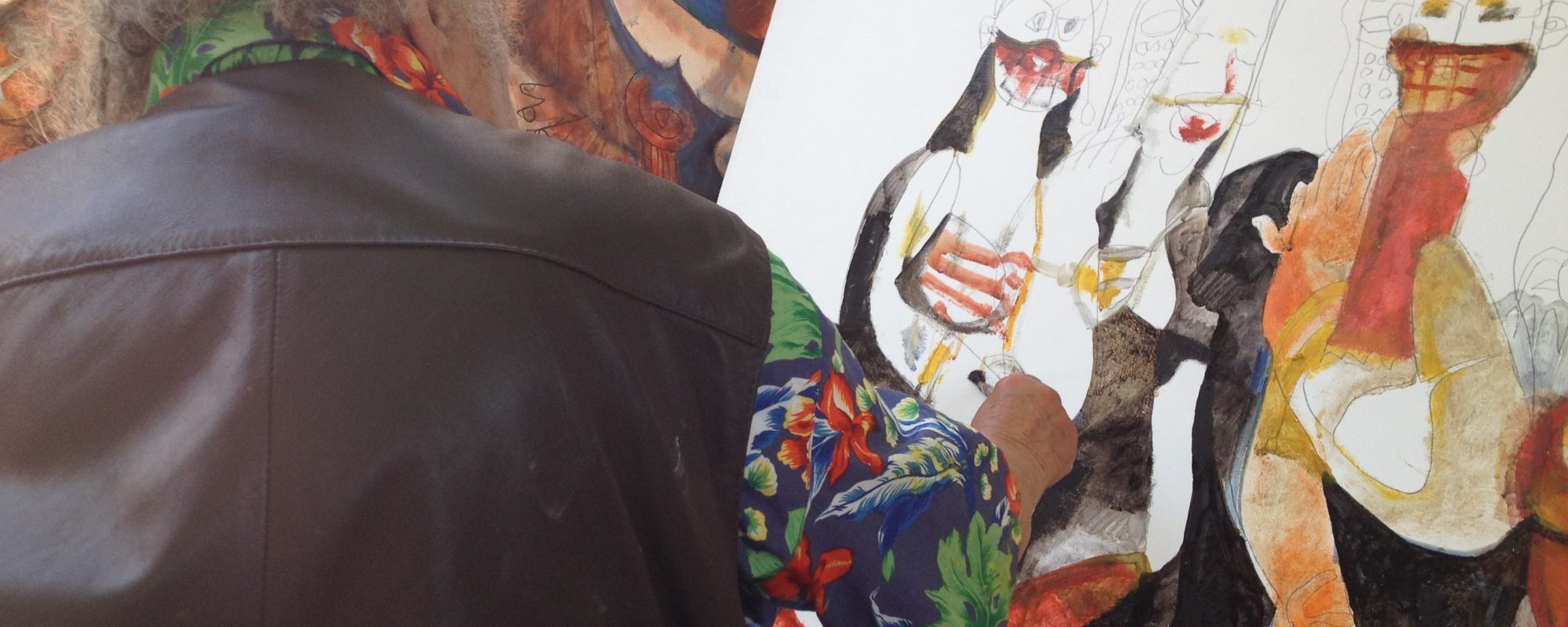July 11, 2015
A source in Beirut tipped me off. Somebody had stolen paintings—two hundred paintings—from Egyptian artist George Bahgory.
Five months earlier, I attended the opening of Bahgory’s retrospective. Scores of elegant Cairenes crunched toast with black caviar. They roamed through six rooms of paintings, gazing at six decades of work. In the main hall, Bahgory rested on a low chair, flanked by women in fur, hipsters in plastic glasses, former ministers, reporters, jewelers, artists, and the head of the Supreme Council for Culture. An unlikely crime scene.
Bahgory’s head is bald, but long gray hairs linger on the sides, like a pharaonic headdress. The dark bags below his eyes connect to networks of wrinkles, creases from never-ending smiles. His scraggly goatee reaches his plaid scarf, wrapped elegantly around his neck and folded into a leather vest. He wears a velour jacket and black pants. His strong, worn hands clasp a wooden cane. The local press hails him as Egypt’s Picasso, though his slapdash shapes fluctuate from Klee to Klimt. “Born twice: 1935 in Luxor, Egypt; 1970 in Paris, France,” reads his website.
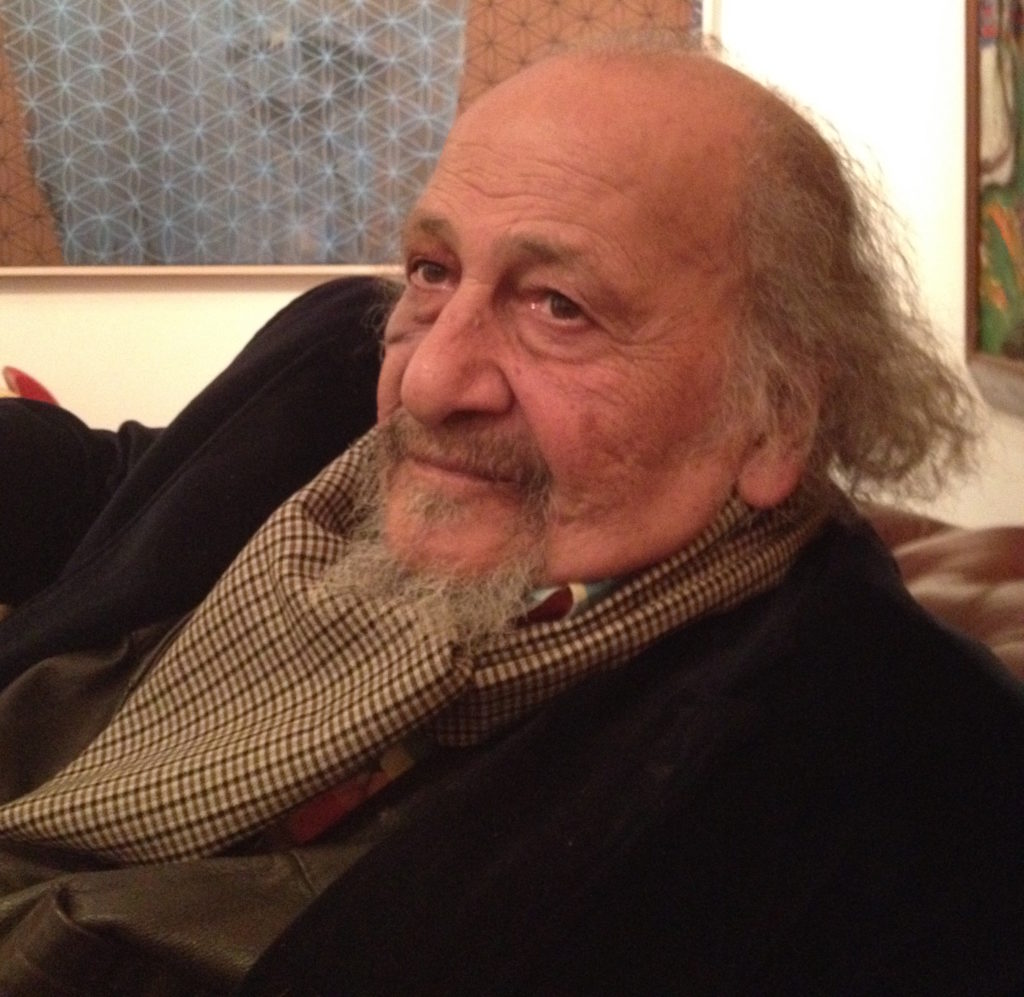
Eleven days after the attack on Charlie Hebdo, Bahgory’s opening at Al-Masar Gallery was an accidental act of solidarity. Bahgory had long sojourned in Paris, where he painted, sculpted, acted, wrote, and cartooned. In the seventies, returning to Cairo was not an option; his bold caricatures of President Anwar Al-Sadat had made the artist persona non-grata. “Je suis Bahgory,” he says.
As we mosey to the gallerist’s office for an interview, genteel women stop to praise Bahgory. He relishes every kiss. We sit on a brown leather couch, below his six and one-half by ten foot mixed media piece, “Bonjour Gauguin.” In it, women lounge, some in pink or orange dresses, others nude. Behind the gallerist’s desk is “The Battle of the Camel,” an abstract of Tahrir Square, February 2, 2011, when Hosni Mubarak sent mounted police after the protesters. In Bahgory’s rendering of the autocrat’s desperate offensive, two massive camels lay prostate; hundreds of demonstrators raise their hands proudly.
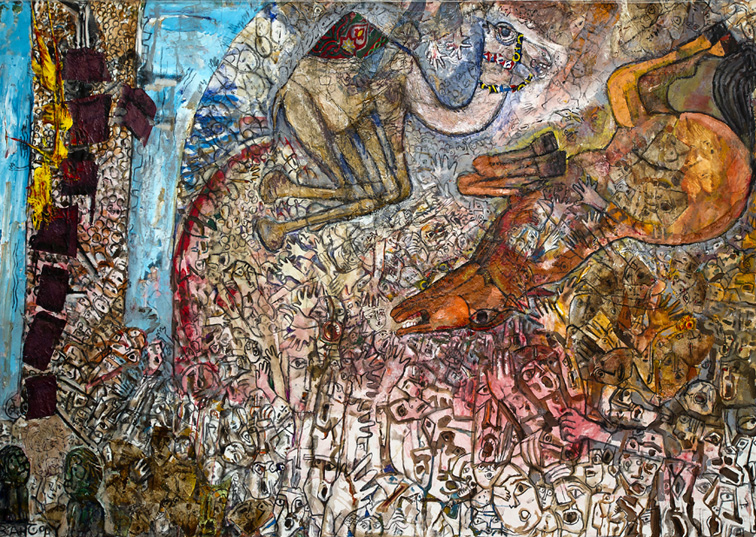
Cameramen and radio journalists crowd, but he savors my attention. Every sentence is an aphorism: “I am against this barbare.” “Freedom has no limits.” As for the role of the artist after a tragedy, Bahgory says, “He is the conscience.”
The gallerist—his hair and suit dark, his smile frosty—reappears in his office, rustling papers on his desk. I wonder why he isn’t hobnobbing. He steals glances at me, the uninvited dinner guest.
I wrap up the interview and drift through the gallery. I look at Bahgory’s Cubist-cum-expressionist smears: silly self-portraits, scenes of card players and shisha smokers, landscapes and cityscapes, nudes and Sufi musicians and flâneurs, from Moroccan medinas to St. Tropez. Of the fifty oils, I am drawn to “The Bread Giver.” Bahgory painted it that month, a flattering caricature of President Abdel-Fattah El-Sisi with hieroglyphic eyes. El-Sisi, wearing an eagle T-shirt, rides a bicycle and delivers bread. Loafs fly in the air, and a couple of women grab the bounty. Here El-Sisi’s hair is thick, despite the president’s male-pattern baldness. I snap some iPhone photos.
On my way out, a musician plucks a harp between two abstract nudes and a cheerful sailboat. The room is empty, so the harpist pauses to type on her smartphone. What I fail to notice: there was no pricelist and no catalog.
“Bahgory Accuses Private Gallery of Seizing His Paintings. Culture Minister Bans [the Paintings] from Leaving the Country without Artist’s Permission.”
—Ahram Gate, April 10, 2015, translated from the Arabic
Fine artist George Bahgory has issued a complaint against a private gallery owner in Zamalek, accusing him of seizing two hundred of his paintings.
Soha Zahran, Bahgory’s activities director, explained in a statement to Ahram Gate that from 2011 to 2015, the artist had frequently exhibited his work in a particular private gallery. Bahgory had left his paintings in the gallery after each exhibition without retrieving them. But after five years, he asked for the return of the paintings.
She added that Bahgory was surprised “by the gallery owner’s repeated refusal to return the paintings. We tried to resolve the matter by friendly means. But the gallery owner refused, denying that any of the artist’s paintings were in his possession. Bahgory penned a misdemeanor complaint against him, number 2518, in the Qasr El-Nil [Police] Station.”…
She also confirmed that the situation would be difficult [to resolve quickly] because the gallery owner had seized 200 paintings….
She added: “George Bahgory, as people know, is kind-hearted and has good intentions, and therefore trusted [the gallery owner] and dealt with him as a close friend. He did not request money or paintings from him. But this person exploited his trust in a nefarious manner….”
In Which Art Theft Makes Prime Time
Newshawks rarely cover the modern Egyptian art scene. Sure, looted antiquities, unearthed tombs, and King Tut’s beard make for good stories. But fine art stays in Cairo’s elite villas and mega-mansions, luxe galleries or experimental collectives—except for the notorious heists at Mr. and Mrs. Mohamed Mahmoud Khalil Museum of Giza.
Khalil Pasha (1876-1953) was a patron of the arts. He bought hundreds of works by Degas, Gauguin, Manet, Monet, Pissaro, Renoir, Rodin, and Van Gogh—a collection worth a cool US$2 billion. His residence was converted into a state museum so lavish that, eight years after the museum opened, President Sadat moved his offices to the Nile-side villa.
The prize of the lot was Van Gogh’s still life, Poppy Flowers. The one-foot-by-one-foot oil was small enough to roll into a backpack—which is basically what happened, in 1978, when thieves snatched the painting. For a full day, the law didn’t even realize the piece was missing. It resurfaced a decade later in Kuwait and was returned to the museum. Francoise Cachin, director of the Musee d’Orsay, confirmed its authenticity: “It is real, absolutely real, without doubt.”
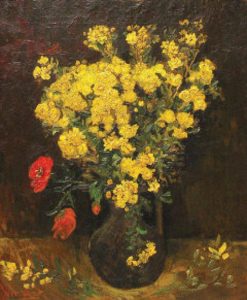
August 2010: two sneaks swoop into the museum, use a couch as a ladder, and slice the Van Gogh off the frame. Just seven of the museum’s 43 security cameras were functioning. The crooks vanish into the daylight.
“Each painting in the museum has an alarm. Not a single alarm for any painting is working,” says Prosecutor General Abdel-Meguid Mahmoud at a press conference. A US$50 million job. As reporters crowd in the museum to snap photos, someone trips, knocking a statue of Cupid. It shatters.
Culture Minister Farouk Hosni manages to keep his post, but his colleagues aren’t so lucky. The North Giza prosecution charges 15 officials with negligence, bars ten from leaving the country. Two years later, an appeals court sentences the Deputy Culture Minister “to one year of hard labor in prison on charges of neglecting his duty,” according to the state news agency. The museum’s security chief got a half-year of hard labor. The nicked Van Gogh remains at large.
This time around, I told myself, they wouldn’t get away with it.
Bahgory is no Dutch master, but his works are national treasures. Bahgory is a giant of Egyptian modern art. He paints old-fashioned folkways and modern rites. He grapples with the country’s long-lost cosmopolitanism. He romanticizes the past and relives it. The octogenarian’s paintings were destined to be a part of a dedicated museum. Soha Zahran, the artist’s spokesperson, values the 200 paintings at 10 million Egyptian pounds (US$1.3 million). Many of the paintings from the January retrospective—his formative works, oils from the 50s and 60s—were not for sale. Some had been flown in from a club in Paris. One person active in the Cairo art scene described the paintings’ disappearance as “a very calculated operation.”
There is one prime suspect. On April 25, the evening program Al-Sada Al-Mohtaramoun (The Esteemed Gentlemen) ran a segment called The Artist George Bahgory and the Truth about the Seized Art Pieces. “There was a great friendship between me and the gallery owner at first, but only at first,” says Bahgory. An aging Jerry Garcia figure, he dons a button-down with red, yellow, purple and green zigzags under a black leather vest. His sullen eyes stare at a canvas as he paints. The camera pans around the studio, brimming with his statuettes and cubist nudes. Oriental music crescendos. “I want the old drawings. I want them to come back. That’s it,” says the artist.
Presenter Youssef Al-Hosiny wears a khaki blazer, navy shirt, and five-o’clock-shadow. On the live broadcast he phones the owner of Al-Masar Gallery, Waleed Abdulkhalek. “I am a big fan of your program, by the way,” the gallerist begins. Abdulkhalek explains that after the retrospective, Bahgory never showed up to get his paintings. Al-Hosiny buffs his chin, writes notes on a pad, while to his left the montage of Bahgory’s studio plays. “Okay, sir, are any of Bahgory’s pieces in your possession, or in the gallery’s storerooms, on in the gallery [itself]?” asks the anchor. Abdulkhalek starts to ramble, saying that he respects the law. Hosiny keeps grilling the gallerist.
Abdulkhalek pauses and says, “We have several of the pieces,” and that he is complying with the investigation. “Respecting the investigation has nothing to do with whether you can tell me, ‘Yes, these are the pieces of Bahgory, and we have this many.’” The men talk over one another. Al-Hosiny raises his voice: “Right. OK. Sir, tell me, for instance, ‘I have two-hundred pieces.’ or ‘No, it’s one-hundred.’ Or ‘No, it’s thirty.’ Or ‘There are no pieces.’” “Excuse me, excuse me. I want to tell you about something, sir,” says Abdulkhalek. “The artist has no evidence.”
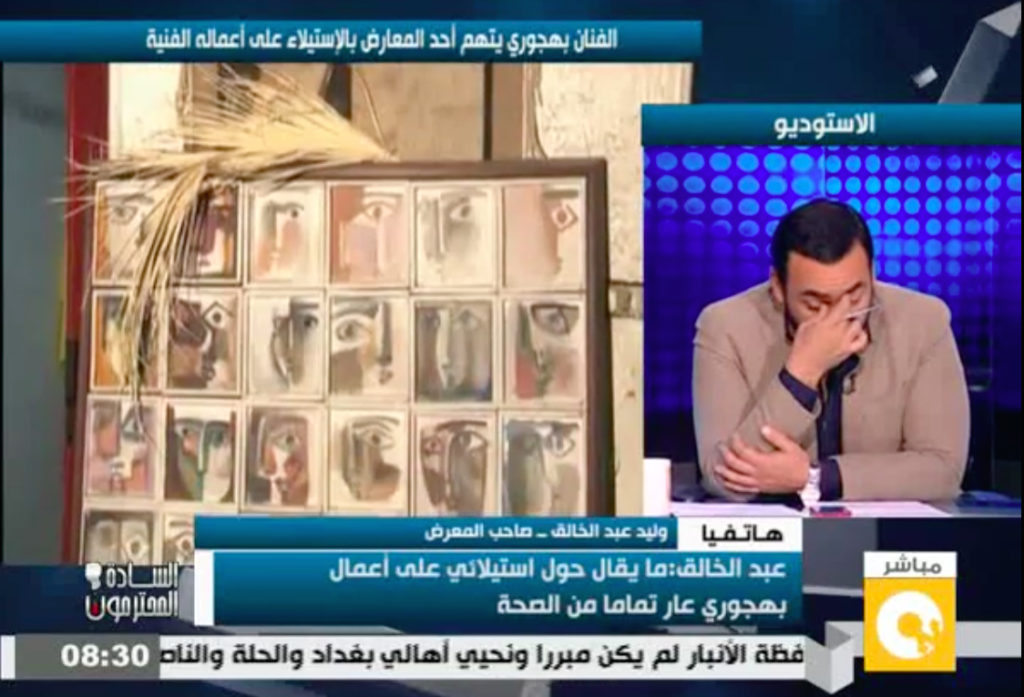
Al-Hosiny rubs his eyes. His jaw hangs open. “Let’s say I were a painter—I had been painting for a while, and I wanted to do a show with you[r gallery], who would take the paintings [from me]?” The gallerist explains that the artist just drops off his works. This hypothetical continues for a minute, until Al-Hosiny realizes he is getting no closer to the truth.
I watch the clip on YouTube several times and then ring Bahgory’s cellphone. “Come to my studio after one hour,” he says.
“GEORGES BAHGORY│BIOGRAPHY”
Al-Masar Gallery Press Release, January 19, 2015
Georges Bahgory was born in 1932 in the Upper Egyptian village of Bahgora; from which his family name originates. Bahgory’s traditional upbringing had a crucial influence on his artwork and his subject matter in particular. Bahgory has always been overwhelmed by people, which is shown in most of his oil paintings. The artist’s body of works depicts people and street life with all its diversified Egyptian labor. The artist tackled Islamic subjects, politicians, motherhood, musicians, and many others. Bahgory studied Art at the Faculty of Fine Arts in Zamalek, Cairo in 1955 and at the Academy of Fine Arts in Paris in 1970. His 30 years stay in Paris refined his talent in drawing, engraving, painting, sculpture, marionette art, novel writing, cinema and criticism.
Upon a special invitation from the Society of Art Lovers in Paris, his works were selected to represent the Egyptian Pavilion at Louvre Museum in 1999….
—Al Masar Gallery for Contemporary Art is the Artist’s exclusive representing Gallery and sole Agent.
In Which the Artist, Despite Everything, Paints
Bahgory’s studio is on Maaruf Street, which means “well-known” in Arabic. His neighbors know him well: the eminent painter who visits Paris annually. The junction of Maaruf and Champollion Street is a hub for auto parts, where mechanics tune up heaps and hotrods. I ask a young mechanic, and he walks me to the third alley. A sign with Ottoman-style calligraphy marks the gate. The door is unlocked. I let myself in.
In the foyer are a couple of easels and canvasses, a wood bookshelf of antique Arabic volumes, and a white board with visitors’ greetings and sketches. The walls have drawings of Bahgory and by Bahgory. I ascend the narrow flight of stairs and enter a messy floor of canvases, books and sculptures, a kitchenette tucked in the corner beside an annex with dozens more paintings. His assistant Safwat opens the terrace door, and into the dusty office the sun glares.
It’s a hundred-degrees. Bahgory sits in the shade facing three easels. He methodically paints. I set a box of cookies on the table. He barely notices me, even as I crouch beside him. Outside cars honk and shopkeepers quibble, but Bahgory’s eyes are trained on a Photostat of a painting by Mahmoud Said (1897-1964), “The Medina.” The original is an eleven and one-half- by six and one-half-foot oil that hangs in the Egyptian Museum of Modern Art. In 2010, Christie’s Dubai auctioned a Said for US$2.4 million. Maybe Bahgory hopes to get a cut of the Mideast art market action.
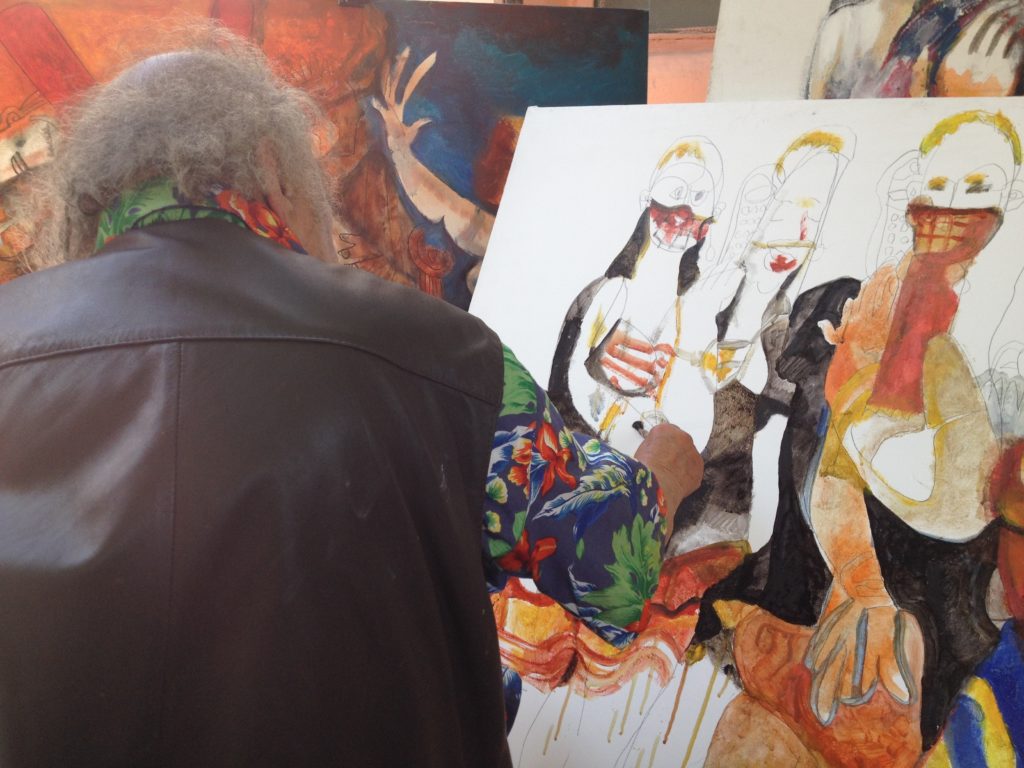
Bahgory’s grimace clashes with his blue Hawaiian shirt, adorned with red flowers. His chinos are splattered with paint, as if he’s worn them for decades. The tables beside him are covered with brushes and pencils, palettes, tubes and tubes of oil and acrylic. Some have daubed his large mobile phone. An assistant, Dina, serves us hot tea.
I ask Bahgory about the history of Egyptian caricature, his favorite painters. The eighty-three year old dozes off midsentence.
Bahgory is now a celebrated artist with close relations to officials. But recent reports in the local press fail to mention that, in the seventies, President Sadat blacklisted him. Bahgory decamped to Paris, where he caricatured Sadat trapped on a desert island, the president’s ship sunken; or as a mechanic ripping apart a car labeled Egypt. (Those cartoons are published in a book called Banned Drawings, which is out of print.) For his pioneering work, Bahgory earned the title “the granddaddy of Egyptian caricature.” Fearing retribution, he did not return to Egypt until Sadat passed. “I packed my bags and left when I had no money, no friends, nothing there,” he told the glossy Egypt Today in 2003. “Yet I knew my brush would put bread on my table wherever I went.”
“People love Bahgory,” says Stefania Angarano, director of downtown Cairo’s Mashrabia Gallery. “And yes they come to buy Bahgory,” she says. One Bahgory exhibit enables the gallery to finance a year’s worth of shows by emerging artists. Customers, she tells me, are often more attracted to the man than the work; they like to sit with Bahgory over tea, where he will draw a caricature and share smiles and laughs.
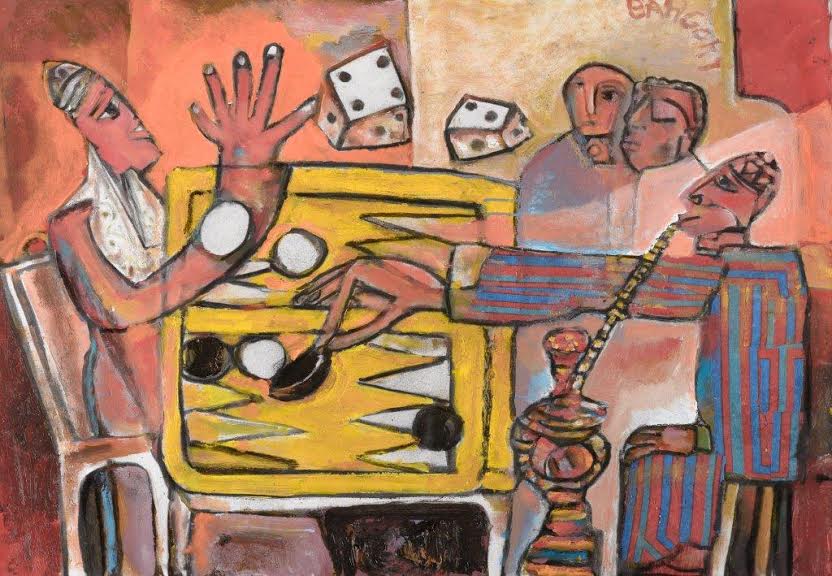
“It’s very Egyptian. [In his paintings] you have the Coptic, the pharaonic, the Islamic—he celebrates Ramadan in his work,” says Fatenn Mostafa, owner of the gallery ArtTalks Egypt. Some paintings allude to Picasso, Cezanne and Gauguin. “He used Western representations of art styles but he Egyptianized them.” Indeed, Egypt is his obsession. In his works, most of the scenes are local: men around a backgammon board, a doorman at a house’s gate with his family, or more recently the 2011 uprising. “For me, he is a true Egyptian artist. In a cubist way, yes. In a sarcastic satire way, yes,” says Mostafa. “Fifty years from now, you will look at some of the works and you will say this is part of our history.”
I look around at Bahgory’s outdoor studio, the sculptures and the cacti. Not a cloud in the sky. Twenty minutes later, the painter stirs. The cookies have melted, but he insists I eat one. It’s time to ask him about the case: What happened to the pieces? He takes long pauses, as if I had just reminded him of a long-forgotten skeleton hanging in the back of his studio. Shaky hands ignite a cigarette. “He’s lying and making bad things. I called him and he doesn’t answer,” Bahgory says in English. “He can have a lot of money, and he can go to the first people who can take it. He can go to Christie’s in London. He is very clever.”
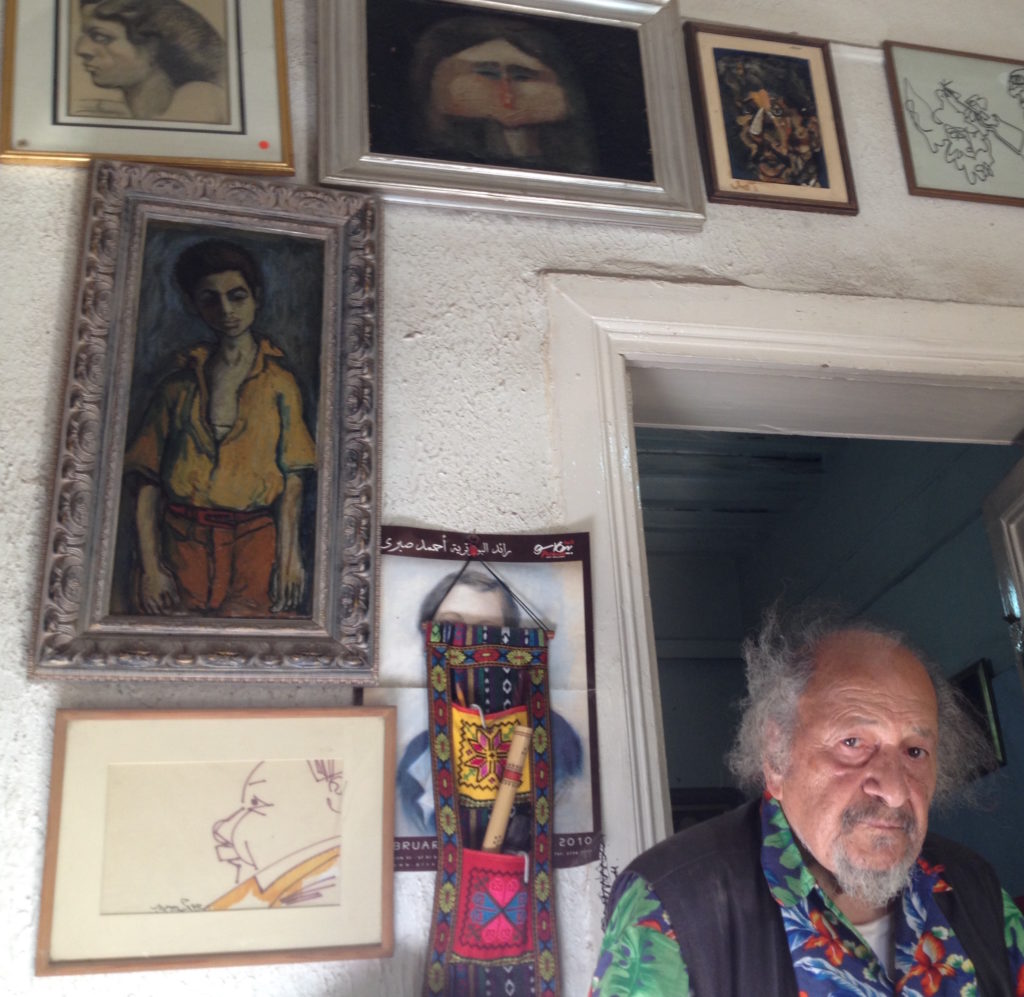
I ask for details. He draws the cigarette deeply, coughs, and reaches for the glass teacup. He looks me in the eye and answers in English. “Right now,” he says, “I am very confused because I have nothing. And I want to do something, but I have none of my paintings. These are not the same,” pointing at the canvases. His voice crackles.
Bahgory stands, walks to the door and opens it. His office’s walls are a collage of posters, gallery shows from Paris and Cairo, clipped cartoons, and a photograph with Naguib Mahfouz. On the door, phone numbers are written in ink. He runs his finger along them. He asks me to call Waleed Abdulkhalek there and then. I hesitate, realizing that I have reawakened Bahgory’s anger, and tell him that I’m out of phone credit. I am not ready to provoke Waleed.
First, I need to get the facts straight. I need to meet Soha Zahran, who handles the artist’s business.
“Petition to Waleed Abdel Khaleq Gallery owner who has some Bahjory paintings and not retuned them yet! Egypt freedom of art!”
—Change.org, April 22, 2015 (typos from the original copy)
Mr. Waleed Abdul Khaleq
Director / owner of Gallery Masar
Zamalek – Cairo / Egypt
Greetings,
I have provided you two hundred (200) pieces of my paintings over the past five years to be displayed and sold in various exhibitions held in the gallery Masar that you own according to a word of honour between us.
Today, after the end of the last exhibition which was held in January 2015 I did not have any payment regarding any sales that happened through those years I haven’t been successful in getting the rest of the paintings that have not been sold.
So I hope you could help as soon as you can in providing me full information about how many pieces were sold and the price tag they were gone for as well as pay me my share and return the 40 paintings you got that were not up for sale.
As you know those paintings are all what I got, I feel proud and treat them as my own children so i do request you not to take them away from me.
Thanking you for your cooperation and I am confident in your desire to preserve the rights of others and respect for the word of honor between us.
George Bahjory
In Which a Pure Heart is a Liability
After a week of terse phone calls and text messages in Arabic, Soha Zahran calls me back: “Meet me at the Shooting Club at three. Tell the doorman you’re there to see me.”
In 1938, King Farouk established the Royal Egyptian Shooting Club. Today it’s one of many upper-class social clubs, though this one has the soundtrack of gunfire. Set back from the street, the club looks like a large privately owned public square. Banks, chain stores and grey residential buildings and offices surround it. There are ten gates, dotted with palm trees and guards eating lunch. My driver pulls up Gate 1, and I phone Zahran. “Go to gate ten. Your name is on the list,” she says. We drive around the club again, catching glimpses through the fence of tennis courts, a soccer pitch, and several cafes.
I enter the gate by foot, into a private parking lot. I breeze past a metal detector. Beside the electric arch, a guard sits at wooden desk. He peers at a list. “Mr. Jackson?” he asks. “No, it’s Mr. Jonathan.” “Okay, please,” he says, waving me in. Where is Ms. Zahran? “She is at Le Poire,” he says, pointing to his left. The bar? We both laugh. (The Arabic alphabet lacks a “P,” so speakers substitute a “B”; Le Poire sounds a lot like Le Bar.) There’s no bar here. I walk twenty meters toward the café.
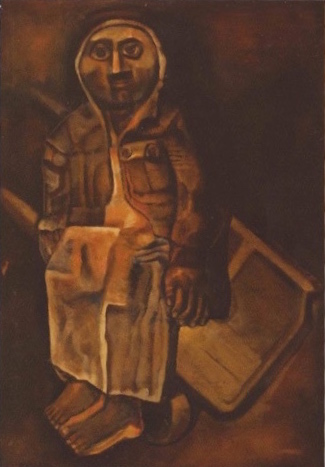
Soha Zahran sits under a covered veranda; atop the café table is an untouched croissant sandwich. She wears jeans and a white T-shirt that says “U SNOOZE, U LOSE” in shimmering gold type, which matches her hoop earrings, bracelets, rings, scarab necklace, and sandals. She offers me the sandwich. I decline. A club employee appears and hands her two packs of light cigarettes. I set my panama hat on the table. We both order colas.
Before Zahran came along, the artist conducted his own business. “I just started working with Bahgory on this case. Had I been working with him prior to this, this never would have happened at all,” she says.
A longtime Bahgory fan, a lawyer by training but not by profession, she filed the complaint with the police and another to the Syndicate of Plastic Arts. She made certificates to verify the provenance of Bahgory’s paintings. She boasts of meeting with the Culture Minister, who has adopted exceptional procedures, banning the export of Bahgory’s works without his permission. Yet documents show that some of artist’s paintings have already left the country. I might be too late.
She won’t put me in contact with the lawyer. She won’t share a copy of the police report. She asks me to sign an online petition demanding that Abdulkhalek return the art, which I tell her would compromise my objectivity. Sorry, Ms. Soha. Her phone rings, and she chatters with an artist seeking to support her campaign.
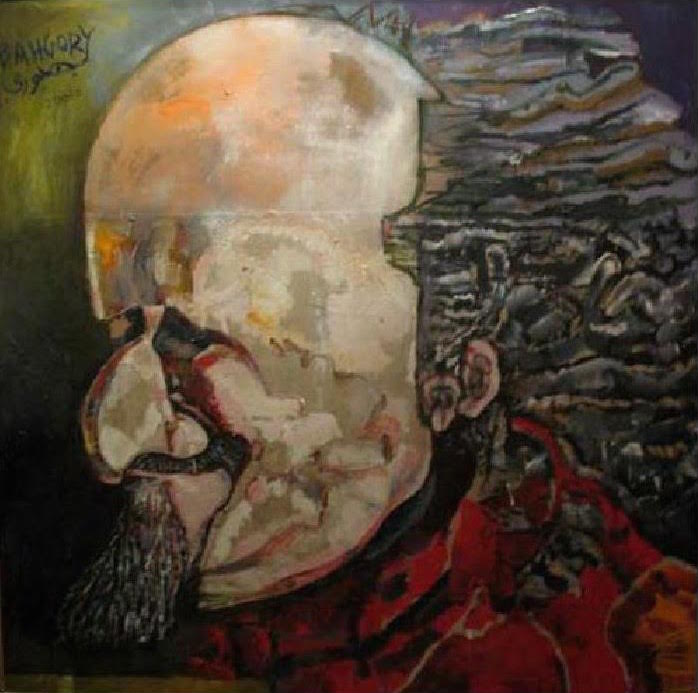
Seldom do artists in Egypt have contracts with galleries, she explains. Most sales are transacted through handshakes and relationships, not paper trails. If Bahgory’s case arrives on the general prosecutor’s desk, or in court, the law might be on Abdulkhalek’s side. There’s no list of the paintings delivered, received, or sold. After losing the paintings, Bahgory could also lose the case. “George’s problem,” she says, “is that his heart is pure.”
She hisses at a cat creeping toward the uneaten sandwich.
I wonder what gallerists think of Waleed Abdulkhalek and the Bahgory case. Three weeks later, Fatenn Mostafa, invites me to her gallery at midday. ArtTalks Egypt is on the fourth floor of a rectangular building beside the brutalist Embassy of Romania. It faces a pink villa, once the maison of painter Queen Farida (who divorced King Farouk in 1948), now the residence of the Canadian Ambassador.
The elevator is cramped and jittery. There is a beep when I enter the gallery’s glass door. Sunshine illuminates the room, and speakers play jazz. Large nightmarish paintings hang for a show called “The Forbidden.” Each painting has the price listed below the description. Most run about 55,000 Egyptian pounds (over US$7,000), relatively high for the local market. Four or five young assistants run about, from the annex to the office. A young man brings me a tray with a coffee mug and a water glass. I sip it while sitting on a black leather couch, flipping through catalogs and books, including Bahgory’s Legacy. Adele is now singing. The phone rings every few minutes.
Ten minutes later, the assistant leads me into her office. “Do you mind if I smoke?” says Fatenn Mostafa. The stones on her necklace and bracelets twinkle. On her desk are papers, binders, and a lit candle.
She discusses the poor management of the ministry: “I challenge the Minister of Culture—or the head of the Fine Arts Sector—if he’s really deeply knowledgeable about our history of modern art.” She laments over the state’s vast modern art collection, which is unavailable for public viewing: 15,000 pieces, “but probably five-thousand are crap.” She tells me that each major Egyptian artist needs a catalogue raisonné: theft and forgery are rife, and “there’s little documentation.”
When she asks me what I am researching, I point to the caricature on her wall, a portrait of her drawn by the man in question.
“It’s very easy to fool George Bahgory,” she says, speaking of Waleed Abdulkhalek. “He has them. He stored them somewhere because then when George dies he will bring them in ten-years time. That’s exactly what is going to happen.”
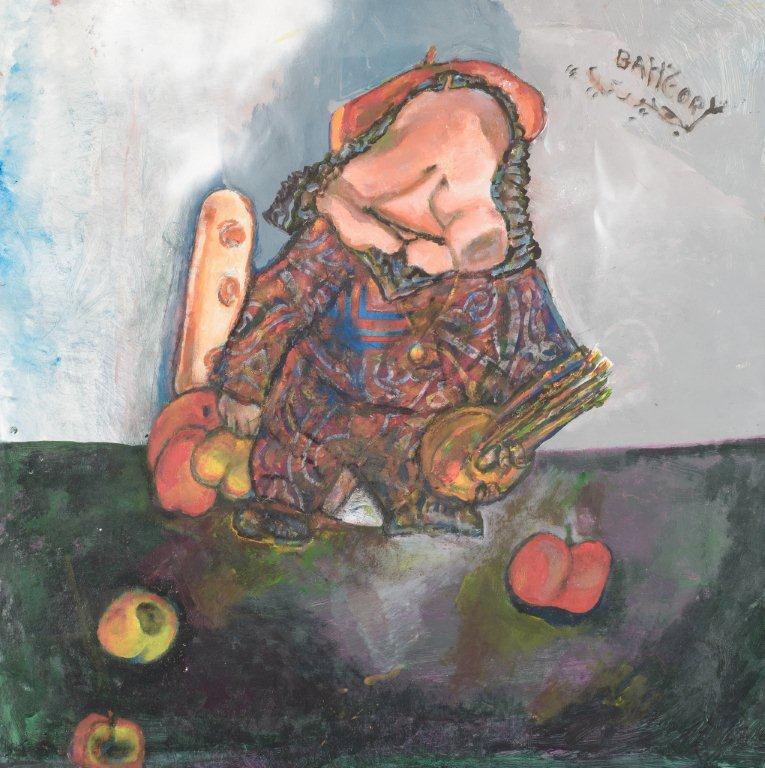
“I’m torn. I’m heartbroken,” she says while clicking through a slideshow of his pieces. Mostafa and her colleagues are compiling a catalog of Bahgory’s unaccounted paintings, by her count 208. “Look at this— it’s beautiful. These are beautiful works. Look at this.” Her PowerPoint includes the covers of the catalogs for Bahgory’s four shows since 2011. “These works— [Abdulkhalek] priced them for US$65,000. George Bahgory never sold for this price.”
Abdulkhalek has a bad reputation. When he sells the paintings, each customer is offered a different price. “Why is there no price list? Everywhere in the world there is a price list,” Mostafa says. “I know the art world is not transparent worldwide, by the way—it’s not just Egypt. There is a lot of fishy-wishy stuff. I am not denying that. But to that extreme—it’s too blatant in my opinion.”
So where are the paintings now? “I’m sure he did get a lot out of the country,” she says. Unstretch the canvases, put them in your luggage every time you or a family member leave the country. “It’s very easy.”
Al-Masar’s Gallery Statement
—From the gallery’s website, http://almasargallery.com/about-almasar
…AL MASAR gallery is both the path and the trace as a cultural nexus of exhibitions and documentation to define the genuine value of modern and contemporary Egyptian art.
[Al-Masar, in English, can be defined as route or path, trajectory or orbit.]
Al Masar Gallery | Contemporary Art presents a unique service of building a Modern and Contemporary Egyptian art collections. A service designed to meet our client’s unique needs objectively and with discretion, we are also pleased to educate and advise the collector prior to acquisition and to reappraise pieces as their value fluctuates. Such services includes:
– Confidential consultations, advice on new trends, value and quality of Egyptian Art.
Al Masar recognizes that art, and collecting art is not only a highly aesthetic endeavor, but also a form of asset allocation, consewuently [sic] Al Masar Gallery is ready to serve art collectors and cooperates for:
– Strategic planning services tailored to the creation of an art collection or the enhancement of an existing one
– Research and development activities to source and acquire artworks across the Egyptian markets
– Transaction representation on behalf of private clients
– Auction & Art Fair representation to ensure client confidentiality
– Full support for clients selling individual pieces or an entire collection
– Comprehensive assistance with insurance, shipment from Egypt to anywhere in the world.
Waleed Abdulkhalek
Founder & Managing Director
In Which Abdulkhalek Advises Me in Buying Fine Art
One afternoon, I wander into Al-Masar Gallery. The gallery is on the first floor of Baehler’s Mansion. Swiss entrepreneur and hotelier Charles Baehler constructed the twin buildings, with French windows and oversized gates, in 1927 to 1929. Today, they accommodate upmarket restaurants, bookshops, and antiquarians.
Inside is a show by American-Sudanese artist Mohammed Omar Khalil, “The Nile: A River of Continues Inspiration [sic].” The pieces are monstrous and wretched: collages on wood pieces, splattered with oil paint, newspaper fragments, fabric and photographs pasted atop. Waleed Abdulkhalek is out. I write my name and number on the gallerist’s desk and notice a desktop computer logging several surveillance cameras. His assistant phones me several days later, tells me to turn up on Thursday.
Abdulkhalek smiles when I enter the gallery. He wears a white dress shirt, dark blazer, and jeans. We sit on two chairs in the main hall. He offers me an espresso, which his assistant serves in an angular, tres moderne mug and saucer. Abdulkhalek recognizes me from Bahgory’s retrospective, but shifts the conversation to Art Basil and the Los Angeles Film Festival, Giacometti and Warhol. He chats about Barcelona, Paris, Sao Paolo, and Tokyo. He brags that the theme for this year’s New York Armory show, Arab art, was his idea.
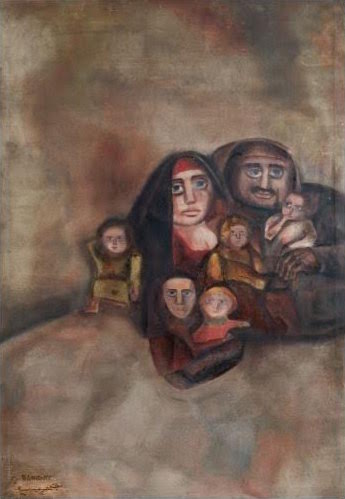
After finishing university, Abdulkhalek went to the Ministry of Culture, working closely with then Minister Farouk Hosni. (Some say that Hosni had a role in financing Al-Masar Gallery.) Abdulkhalek managed art collections for the ministry’s venues and later its foreign exhibitions. “This strengthened my relations with artists. Many artists who are stars of today—I have discovered those ones, and I brought them to work in cultural palaces and put their paintings in public libraries,” he tells me. “I didn’t just fall from the sky.”
We talk about 107 years of Egyptian modern art. When I ask Abdulkhalek about the theft of the Van Gogh, he chuckles. “It’s an amazing story but I tell you something, this painting is destined to be stolen because that was the second time.” I swallow my tongue and try to act natural.
What makes a good Egyptian art collection? Does Egyptian art sell? Who buys it? I carry on with prepared questions “Art is a stock, but you get daily dividends. And the jumps in price, no stock will do. This is the importance of investing in art,” he says.
Since he hasn’t mentioned George Bahgory once, I have to ask: if I were to buy a Bahgory, would that be a good investment? Which one should I buy?
“I will give you my advice. If you want to invest, at this moment, Bahgory is here—like you said, he is still working. You [should] invest in a late artist, because the market will dry out possibly and surely, and very soon, of late artists’ works,” he says. So dead artists are where money can be made. “That’s right. A good investment now is to focus on buying, even a small work, by a late artist.”
I ask him why Bahgory is not an essential component of an Egyptian art collection. “He defined himself since the beginning, as a caricature artist. That’s his path he chose for him[self]. And he was doing painting. For me, I don’t do caricature, so I just focused on the other side. But the complete definition, he is a caricature artist.”
“Caricature is like the flash of the camera, the snapshot of time, of this moment. But when you jump into art, Jonathan, you have jumped into the ocean,” Abdulkhalek says with a laugh. “It is not a lake anymore.”
When I bring up Bahgory’s style, influences, and legacy, Abdulkhalek steers the conversation elsewhere. His assistant brings me a stack of catalogs from Al-Masar’s archive. I consider asking why Bahgory’s retrospective, “59 Years of Art,” has been scrubbed from the gallery’s website. Instead, I ask him for the catalog of Bahgory’s retrospective.
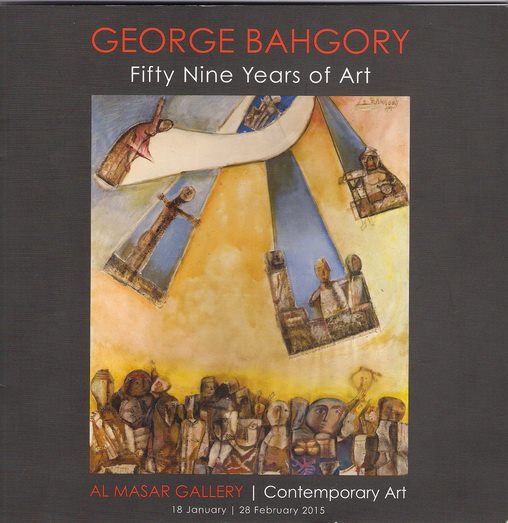
“Actually this catalog was spoiled in printing twice,” he says. “We don’t know why—it was a big, big disaster between us and the printers.” (Fatenn Moustafa told me that she has a copy of that catalog: “You see. He’s lying to you. Isn’t this an indication of a lie?”)
Abdulkhalek is talking about France’s connection to Egyptian art, so I ask again about Georges. “Yes, but Bahgory is not one of the famous ones.”
I put my notebook in my briefcase and switch off the tape recorder. I rise and finally rap him on the knuckles: I heard a tall tale about Bahgory’s 200 missing pieces, Waleed. What do you make of it? “Don’t believe a word,” says Abdulkhalek. “It’s a scam started by the people around him.”
As I walk toward the door, he adds, “Don’t care too much for this story because it’s completely untrue. One-hundred percent untrue.”
“Culture Minister Responds to Bahgory’s Allegation”
—Al-Ahram, June 7, 2015, translated from the Arabic
… Culture Minister Dr. Abdel Wahed Al-Nabawi said that there has been an attack against the fine artist George Bahgory, following the gallery owner’s burgling of his paintings.
He stressed that the law forbids such an assault against the artist and his work, indicating that the Fine Arts Sector [of the Ministry] would continue to follow the incident.
He continued: “I do not permit anyone to attack the work of a great fine artist like Bahgory.”…
In Which Mr. and Mrs. Bahgory Depart for Paris
For another three weeks I have been calling and texting Soha Zahran. Sometimes she answers but just as often not. One day, she picks up the phone and tells me that I will have a hard time getting ahold of the new attorney. “It’s Mortada Mansour,” she said.
Every Egyptian knows Mortada Mansour. A former Mubarak operative and a TV talking head, he owns the high-profile Zamalek soccer club. Mortada even ran for president. “Whether he is being doused in urine, as he was in October, or sued seven times for libel, it is hard to keep him out of the news,” reported Patrick Kingsley for the Guardian.
“Mortada Mansour,” said Fatenn Mostafa, after phoning her source, “is not yet officially on board. He will be as of the tenth of Ramadan… Once they meet him and it’s finalized then you can meet him.”
But Bahgory isn’t answering his cellphone and I want an update. Finally, I reach him midday on Sunday, the beginning of the Egyptian workweek. “I am going to Paris tomorrow,” says Bahgory, a holiday timed with Ramadan. “Come by in two hours.”
As I enter his studio, they are already out the door. Dina, his assistant, asks how my research is coming, hoping for a quick answer. Mrs. Bahgory, purse slung over her shoulder, looks me up-and-down. The painter wears a khaki vest over his orange shirt, which matches his pumpkin shoes. He smiles. He doesn’t recall fixing a meeting for today. I’m not sure if he remembers our interview last month. “What’s new?” I ask him in Arabic. He frowns.
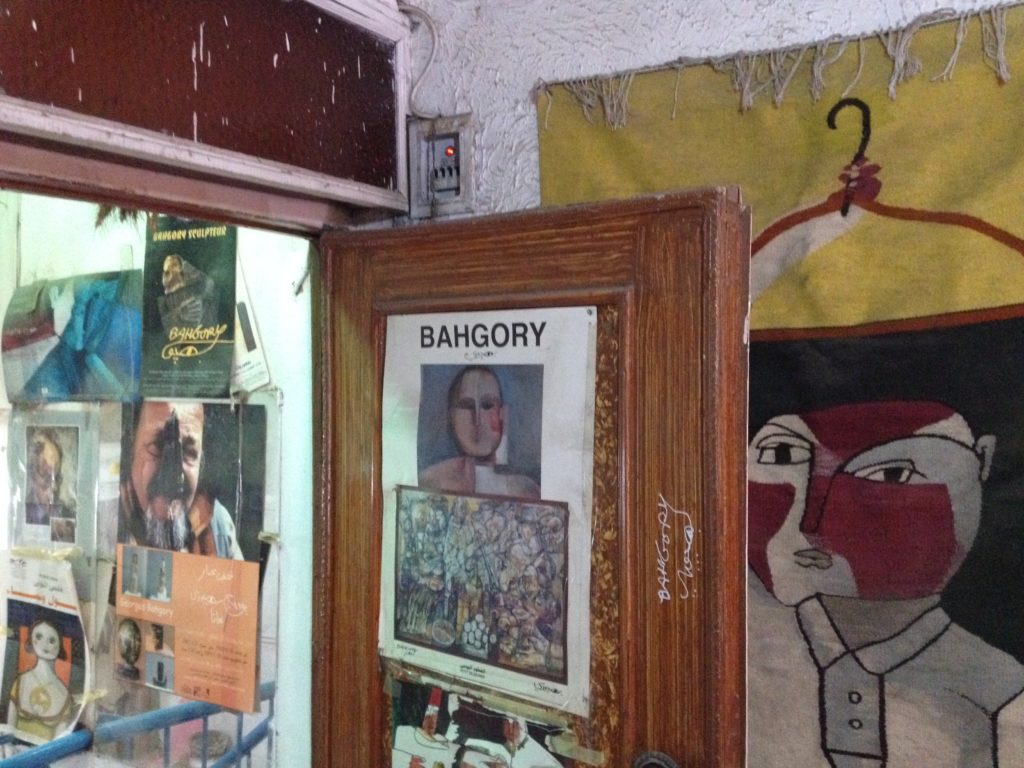
Mrs. Bahgory and Dina hurry downstairs while he answers a call on his cell. “Bahgory! Bahgory!” one of the women yells from the street. The doorbell is ringing, though the dingdong does not expedite the departure. He takes his time and finishes the call. He exchanges pleasantries with Safwat and moves very slowly down the stairs.
I walk with him down Maaruf Street. I offer him my arm for support but he’s too proud to take it. Around the corner, a sedan waits with the motor running, Mrs. Bahgory in the backseat and Dina driving. I open the car door and wish him well.

